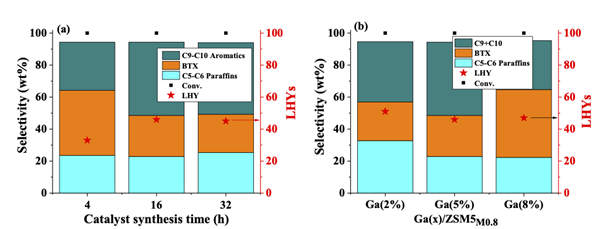Relationship Between Zsm-5 Pore Modifications And Gallium Proximity And Liquid Hydrocarbon Number Distribution From Ethanol Oligomerization
Patent Status
| Country | Type | Number | Dated | Case |
| Patent Cooperation Treaty | Published Application | WO 2023/224867 | 11/23/2023 | 2022-867 |
Full Description
Background
A particularly promising route that could facilitate rapid transformation of biomass to low carbon emission aviation fuel, is catalytic conversion of ethanol into Sustainable Aviation Fuel (SAF) that meets energy density and other fit-for-purpose requirements. Many of the alcohol to jet processes that are currently being scaled up require 3 to 4 catalytic steps, require high temperatures and pressures and can suffer from compounding of losses in yield at each step. Recent research studies have indicated that Gallium (Ga) addition to H-ZSM-5 (the protonic or H- type Zeolite Socony Mobil – a catalyst) increased the production of Benzene/Toluene/Xylene (BTX). However, in these cases most of the gallium oxide was shown to be on the zeolite external surface. Reports have indicated that Ga inside the H-ZSM-5 pores enhanced BTX selectivity.
Current Invention
Researchers at UCR have developed a novel, simple synthesis for enhancing the insertion of Ga into the zeolite channels. The invention has successfully demonstrated that enhancing the zeolite pore volumes resulted in longer hydrocarbon chain lengths that are desirable for aviation fuels. Specifically, in their invention, H-ZSM-5 supports were desilicated by treatment with sodium hydroxide (NaOH) to produce mesopore-crystalline H-ZSM-5. Gallium was loaded onto the modified ZSM-5 supports by following incipient wet impregnation procedures and the resulting catalysts were used to catalyze ethanol conversions.

Effect of (a) catalyst synthesis time and (b) Ga content on liquid hydrocarbon product selectivity following reaction of ethanol on Ga(5 wt.%)/ZSM-50.8M catalysts at 350°C with a 0.4h-1 WHSV. Product selectivity is based on total liquid hydrocarbons.
Advantages
The significant benefits/advantages of their invention are:
Suggested uses
Inventions by Prof. Charles Wyman
- Please see all inventions by Prof. Charles Wyman and his team at UCR.
Contact
- Venkata S. Krishnamurty
- venkata.krishnamurty@ucr.edu
- tel: View Phone Number.
Other Information
Keywords
bioethanol, jet fuel, zsm-5, zeolite, aviation fuel, aromatics, long chain hydrocarbons, liquid hydrocarbons
